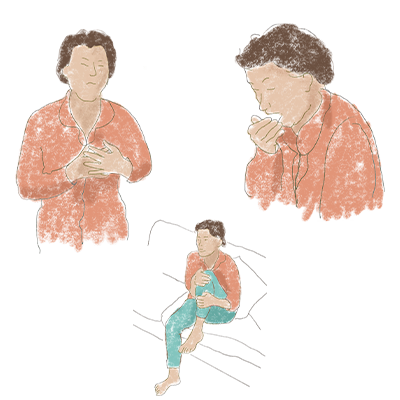Recognising systemic mastocytosis (SM) is an important first step to diagnosing SM.1,2
It can be difficult to recognise SM, but some of the most common symptoms that may prompt testing include:
50%
More than 1/2 of people with SM have red, flat areas of skin covered in small bumps3
Often appear on the thighs or the central part of the body3
33%
1/3 of people with SM experience anaphylaxis, a severe, potentially life-threatening allergic reaction2
Commonly triggered by insect stings but can also happen without a known reason4
Often occurs with low blood pressure, which can be life-threatening4
50%
Nearly 1/2 of people with SM pass loose, watery stools2
Occurs with other symptoms like nausea and stomach pain2
Here are a range of the potential symptoms affecting different organs in SM:2,4,5
This is not a complete list of all the possible symptoms.
Each person with SM is unique and has their own SM story.
How frequent and how severe any of these symptoms are may vary from person to person as well as the type of SM.
WHOLE BODY2,5
Tiredness
Weight loss
Anaphylaxis,
a severe, potentially life-threatening allergic reaction
Feeling unwell
Breathing2,5
Shortness of breath
Congested nose
Throat swelling
Wheezing
MUSCLES AND BONE5
Bone pain
Muscle ache and pain
Bone lesions (abnormal areas in the bones)
SKIN2,5
Itching
Flushing
Red, flat areas of skin covered with small bumps
HEART AND BLOOD VESSELS5
Anaphylaxis with low blood pressure and fainting
Dizziness
Rapid or irregular heartbeat
LIVER/SPLEEN4
Liver dysfunction
Overactive spleen
BRAIN FUNCTION5
Impaired memory/ thinking
Migraines
Sleep disturbance
STOMACH AND INTESTINES2,5
Nausea/vomiting
Loose, watery stools
Stomach pain
Heartburn or reflux
If you think you have symptoms of SM, consult your doctor for an adequate diagnosis and ask any questions you might have about your symptoms and SM.
It can be frustrating and distressing not knowing what is causing your signs and symptoms but speaking to your doctor and describing your symptoms is an important first step towards your diagnosis.
It is also important not to dismiss your symptoms or how you are feeling. Some people with SM can wait several years before speaking to their doctor, which only delays their diagnosis further.6
You know your body.
You know your symptoms.
You are the best person to speak to your doctor about them.
If your doctor suspects that you may have SM after looking at your symptoms and discussing your medical history, they may recommend the following tests:7–9
Serum tryptase test
This test looks for a substance called tryptase in your blood. Mast cells in your body store and release this substance.10 Your doctor or nurse will take a blood sample to measure the levels of tryptase. If the levels are high, it could mean you have a mast cell disorder.
Bone marrow examination
This procedure aims to check your bone marrow more thoroughly, where mast cells can gather.11 It involves a biopsy, where a small piece of your bone marrow is taken to look closely for increased numbers of, or unusual, mast cells. Biopsies are typically performed under local anaesthesia.12
High-sensitivity KIT D816V assay
This test checks for a specific change in the gene 'KIT' that can cause SM. Your doctor or nurse will do a bone marrow biopsy or take a blood sample to look for this change.

